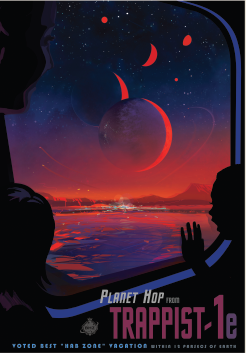A few days ago, NASA put a press release for a major announcement on Wednesday February 22nd, 2017. Rumor was rampant, with speculation everywhere. There was talk about members of the Spitzer Space Telescopes discovering planets, but NASA was tight lipped.

Earlier today, NASA revealed that the Spitzer Space Telescope made the discovery of seven Earth-sized planets orbiting a dwarf star called TRAPPIST-1, which is almost 40 light years away from Earth. Now, 40 light years is close to Earth relative to other celestial objects, which is what is so exciting. Moreover, NASA claims that at least three out of the seven planets are orbiting TRAPPIST-1 in the “goldilocks zone”. The goldilocks zone is important when discovering planets because it’s the nickname given by scientists to the habitable zone for life and liquid water. This ideal distance is from the sun, just so that the planet’s surface isn’t too hot or cold, giving life the maximum possible chance of flourishing. Just like our Earth sits at an ideal distance away from our sun — not too near, not too far – just right.
More information about the Habitable or Goldilocks Zone can he found here. I am glad and amazed that scientists are able to find these planets, as it allows for more discoveries in this space and more people can get involved. There are many citizen science projects in similar fields, that people are involved with, but that is another article. Overall, opening this new avenue for more science is great for the scientific community, and public interest.
Considerations
We do have to realize that even traveling at the fastest speed possible, it would take humans an enormous amount of time to reach these systems. The fastest spacecraft launched so far is the ‘New Horizons’ probe currently past Pluto, and on its way to Kuiper Belt object, 2014 MU69. Its current speed is at around 36,373 mph. (That’s 5,878,499,810,000 miles, or nearly 6 trillion miles traveled so far). New Horizons can travel one light year in 18,449 years, so if humans COULD travel at that speed, it would take 73,796 years to get to TRAPPIST-1. To put that into perspective, according to universetoday, humanity has been around for 200,000 years and civilization has been around for 6,000 years. Therefore, it would take 12.299x the length that civilization has been around to even get to these planets, assuming that we could go that fast.
New Horizons was able to attain the speeds it reached due to the light payload and heavy rocket speeds that it could attain. While it is great that we are exploring these systems, these planets are not accessible to humanity in the foreseeable future. The next step could be funding new methods of solar sail transportation, such as Breakthrough Starshot.
However, if humanity could nail down the transportation issue, the ability to discover these planets makes great targets. Being able to discover these planets should be able to help find closer targets and more of them. These discoveries also improve our understanding of planetary systems, and help push us forward – looking farther than ever before.
Congrats to NASA, this is another great discovery! I would love to visit these planets, and we should use this fostering and funding of new space ventures to also educate people. I believe that education and involvement will be a great way to move things forward.

Be the first to comment on "NASA Finds 7 Earth-Sized Planets But Now What??"